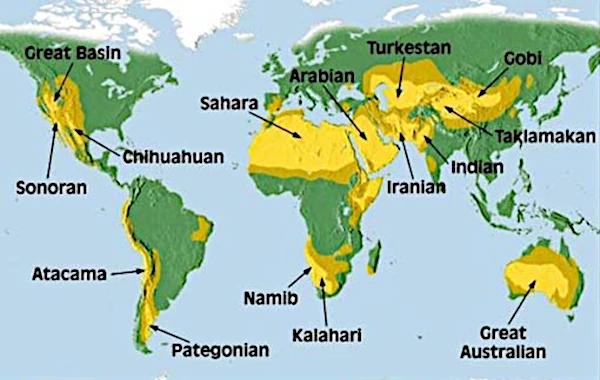
Image Description: The largest deserts in the world.
Deserts are arid regions characterized by very low precipitation and sparse vegetation. They cover about one-third of the Earth's surface and are found on all continents. Deserts are often associated with extremely high temperatures due to their low rainfall and direct exposure to the sun.
The hottest deserts are the Lut Desert (Iran) with 70.7°C in 2005, the Sahara Desert (North Africa) with 58°C in Aziziya, Libya, in 1922, and the Sonoran Desert (United States and Mexico) with 54.4°C in Death Valley, California, in 2013.
Countries: North Africa (Algeria, Chad, Egypt, Libya, Mali, Mauritania, Morocco, Niger, Sudan, Tunisia, Western Sahara)
Area: Approximately 9 million km²
Type: Hot desert
Average Temperatures: 30°C (summer) to 13°C (winter)
Fauna: Dromedaries, fennec foxes, scorpions, snakes.
Characteristics: The Sahara is the largest hot desert in the world. It is known for its sand dunes, oases, and extreme temperatures.
Countries: Saudi Arabia, Yemen, Oman, United Arab Emirates, Qatar, Kuwait, Iraq, Jordan
Area: Approximately 2.3 million km²
Type: Hot desert
Average Temperatures: 45°C (summer) to 20°C (winter)
Fauna: Oryx, gazelles, lizards, snakes.
Characteristics: This desert is characterized by its vast expanses of sand and rock, as well as its high temperatures.
Countries: Mongolia, China
Area: Approximately 1.3 million km²
Type: Cold desert
Average Temperatures: 25°C (summer) to -40°C (winter)
Fauna: Bactrian camels, gazelles, wolves, foxes.
Characteristics: The Gobi Desert is known for its rocky landscapes and extreme temperatures, ranging from -40°C in winter to 50°C in summer.
Countries: Botswana, Namibia, South Africa
Area: Approximately 900,000 km²
Type: Hot desert
Average Temperatures: 35°C (summer) to 15°C (winter)
Fauna: Lions, leopards, elephants, antelopes.
Characteristics: The Kalahari is a semi-arid desert with areas of savanna and scrubland.
Countries: Argentina
Area: Approximately 670,000 km²
Type: Cold desert
Average Temperatures: 15°C (summer) to 3°C (winter)
Fauna: Guanacos, pumas, foxes, rheas.
Characteristics: This desert is the largest in Argentina and is characterized by its steppe landscapes and strong winds.
Countries: Syria, Iraq, Jordan, Saudi Arabia
Area: Approximately 500,000 km²
Type: Hot desert
Average Temperatures: 40°C (summer) to 10°C (winter)
Fauna: Gazelles, jackals, snakes, scorpions.
Characteristics: This desert is composed of steppes and rocky areas.
Countries: Australia
Area: Approximately 339,000 km²
Type: Hot desert
Average Temperatures: 35°C (summer) to 15°C (winter)
Fauna: Kangaroos, dingoes, emus, monitor lizards.
Characteristics: The Victoria Desert is known for its landscapes of sand dunes and salt lakes.
Countries: Turkmenistan, Uzbekistan, Kazakhstan
Area: Approximately 350,000 km²
Type: Hot desert
Average Temperatures: 40°C (summer) to 10°C (winter)
Fauna: Gazelles, foxes, snakes, scorpions.
Characteristics: The Karakum is known for its vast expanses of sand and high temperatures.
Countries: China
Area: Approximately 337,000 km²
Type: Hot desert
Average Temperatures: 35°C (summer) to -20°C (winter)
Fauna: Bactrian camels, gazelles, wolves, foxes.
Characteristics: The Taklamakan is one of the largest sandy deserts in the world and is surrounded by mountains.
Countries: Mexico, United States
Area: Approximately 360,000 km²
Type: Hot desert
Average Temperatures: 35°C (summer) to 10°C (winter)
Fauna: Coyotes, hares, snakes, lizards.
Characteristics: This desert is the largest in North America and is characterized by its landscapes of scrub and cacti.
Countries: Uzbekistan, Kazakhstan
Area: Approximately 300,000 km²
Type: Hot desert
Average Temperatures: 35°C (summer) to 5°C (winter)
Fauna: Gazelles, foxes, snakes, scorpions.
Characteristics: This desert is characterized by its landscapes of steppes and sand dunes.
Countries: United States, Mexico
Area: Approximately 311,000 km²
Type: Hot desert
Average Temperatures: 40°C (summer) to 15°C (winter)
Fauna: Coyotes, hares, snakes, lizards.
Characteristics: The Sonoran Desert is known for its unique biodiversity and varied landscapes.
Countries: Australia
Area: Approximately 184,500 km²
Type: Hot desert
Average Temperatures: 35°C (summer) to 15°C (winter)
Fauna: Kangaroos, dingoes, emus, monitor lizards.
Characteristics: This desert is characterized by its landscapes of scrub and rock.
Countries: Australia
Area: Approximately 176,500 km²
Type: Hot desert
Average Temperatures: 35°C (summer) to 15°C (winter)
Fauna: Kangaroos, dingoes, emus, monitor lizards.
Characteristics: The Simpson Desert is known for its parallel sand dunes and high temperatures.
Countries: Australia
Area: Approximately 155,000 km²
Type: Hot desert
Average Temperatures: 35°C (summer) to 15°C (winter)
Fauna: Kangaroos, dingoes, emus, monitor lizards.
Characteristics: This desert is characterized by its landscapes of scrub and sand dunes.
Countries: India, Pakistan
Area: Approximately 200,000 km²
Type: Hot desert
Average Temperatures: 40°C (summer) to 10°C (winter)
Fauna: Antelopes, jackals, snakes, scorpions.
Characteristics: The Thar Desert is known for its sand dunes and high temperatures.
Countries: Namibia, Angola, South Africa
Area: Approximately 81,000 km²
Type: Coastal desert
Average Temperatures: 25°C (summer) to 10°C (winter)
Fauna: Oryx, springboks, brown hyenas, snakes.
Characteristics: The Namib Desert is known for its red sand dunes and spectacular landscapes.
Countries: Chile
Area: Approximately 105,000 km²
Type: Coastal desert
Average Temperatures: 25°C (summer) to 5°C (winter)
Fauna: Flamingos, foxes, viscachas, lizards.
Characteristics: The Atacama is the driest desert in the world and is known for its lunar landscapes and unique geological formations.
Countries: Iran
Area: Approximately 54,000 km²
Type: Salt desert
Average Temperatures: 50°C (summer) to 10°C (winter)
Fauna: Gazelles, foxes, snakes, scorpions.
Characteristics: The Lut Desert is known for its extreme temperatures and salt landscapes.
Countries: United States
Area: Approximately 35,000 km²
Type: Hot desert
Average Temperatures: 35°C (summer) to 10°C (winter)
Fauna: Coyotes, hares, snakes, lizards.
Characteristics: This desert is characterized by its landscapes of scrub and cacti, as well as its high temperatures.
The deserts of the world are unique and fascinating ecosystems, harboring a surprising diversity of wildlife. Despite the extreme conditions, many species have developed remarkable adaptations to survive in these hostile environments. Understanding desert fauna and their role in the ecosystem is essential for the preservation of these arid regions and the biodiversity they support.